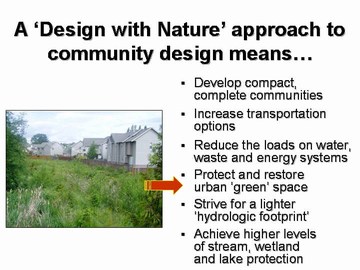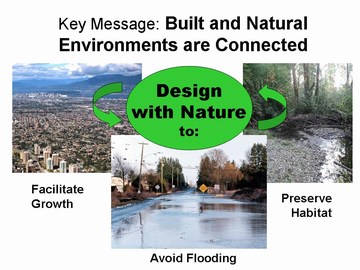Design With Nature to Enhance the Built Environment

Natural systems approach holds key to “creating our future”
Water is a unifying element for growth management in British Columbia. The ‘big picture’ is distilled down to a set of succinct bullets as presented above to focus on what is most important. By building a vision, we can create a lasting legacy.
Creating Our Future
The urban regions of British Columbia are geographically constrained and have little room to sprawl. In Greater Vancouver, for example, this means that 75% of the next one million people will be housed in existing built-out watersheds.

Increasingly, the focus of design professionals is on how to build and/or rebuild communities in balance with the natural environment. Redevelopment and densification are creating opportunities, over time, to reverse past failures.

In planning for the next 50 years and beyond, the vision is one of greener communities that will achieve higher levels of ecological and stream protection. Achieving this outcome will require changes to existing land use regulations, design guidelines and construction standards.
What We Mean by Green Infrastructure
Green infrastructure means use of processes and systems that are natural or mimic nature to provide community services — i.e. design with nature. It means using natural systems for community services like rainwater management, water treatment and public space.

Community Vision: To both accommodate population growth and achieve a community vision for sustainability and liveability, the Green Inrastructure Partnership is encouraging implementation of a design with nature approach to community planning and land (re)development. This requires thinking in terms of a continuum:
– where we are now (the starting point);
– where we wish to get to (the end point); and
– how we will get there (the strategy).
Green Space and Public Health: The design with nature approach embraces what environmental psychologists know: greenspace is fundamental to human health and social well-being. So, as communities in British Columbia redevelop and densify to accommodate more and more people, creation of greenways and greenspace/landscaping takes on increasing importance.
Transportation Synergies: In addition, integration of rainwater management solutions (such as reducing impermeable surfaces) with sustainable transportation strategies (such as grid street networks) can ultimately achieve streets that are are greener in various ways as well as safer and more liveable.
Water-Energy Nexus: At the other end of the spectrum, the design with nature approach also takes into account the ‘water-energy nexus’ – that is, we get energy from water, and we use energy to supply, use and treat water. Water use involves significant energy inputs which must be considered.
Watershed / Landscape-Based Planning:
The design with nature approach also promotes the watershed as a fundamental planning unit, and emphasizes that:
- the Built Environment and the Natural Environment are connected;
- improving the Built Environment can protect or help restore the Natural Environment;
- how we (re)develop individual sites has ripple effects at the watershed scale;
- actions on the ground can result in cumulative benefits over time.

Green Infrastructure in the Larger Context:
Green infrastructure can also be seen in a larger sense as land development that is more sustainable, economically, environmentally and socially. In this way it is similar to the “smart growth” approach to community planning and development. It means means the land use strategies and types of development that creates more compact complete communities, provides diverse affordable housing, and also uses tax dollars more efficiently, preserves green space and working lands, and increases transportation choices.
Municipal infrastructure design focussed on using green infrastructure and incorporating smart growth principles points to local government standards that call for drainage standards based on infiltration, road standards and utility alignments that minimize pavement and give equal weight to the needs of cyclists, pedestrians and drivers, district heating systems, and green buildings.
Implementation Challenge:
The challenge is in moving from planning to action. Effective implementation of the design with nature approach will rely upon changes in policies, programs, applied research, practititioner education and standards of practice for landscape (re)development, transportation and infrastructure servicing.
From a local government perspective, opportunities for implementing on-the-ground changes are found at three scales in areas that are subject to regulation.

Posted January 2006

